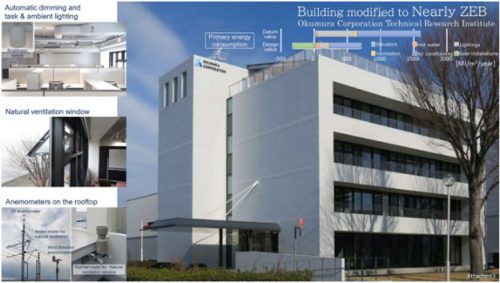
To achieve a zero-emission society by 2050, Okumura Corporation believes it is essential to make positive energy buildings (PEBs) a reality for mid- to low-rise buildings, with their positive energy balance, and then to achieve net zero primary energy consumption for buildings over an entire area by supplying energy under microgrid control to the large high-rise buildings for which achieving net-zero energy building (ZEB) status is problematic.
To make PEBs reality, building energy consumption must be reduced to as close as zero as possible, while surplus renewable energy must be increased. While the efficiency of energy conservation and energy generating facilities is expected to improve, early realization of PEBs requires initiatives to optimize energy for the entire building. To this end, we intend to focus on three methods: (1)Developing comfort sensing and control technologies using information and communication technology (ICT) and Al; (2)optimizing the entire building using optimal EMS to integrate various facilities; and (3)introducing microgrid control and cost reductions for overall systems, including Energy Management System (EMS).
- Developing comfort sensing and control technologies using ICT and Al: Previously, Okumura Corporation focused on the correlation between the comfort of thermal environments and temperature fluctuations over time. Okumura has worked on projects to develop energy-saving air-conditioning control technologies that utilize this relationship. Okumura hope to use ICT and Al in the future to achieve further energy savings through optimal control of facilities and by sensing comfort with respect to light and airflow environments, as well as thermal environments.
- Optimization of entire building using optimal EMS to integrate various facilities: Building facilities consist not just of equipment like air conditioning, fans, and lighting, which converts energy into heat, airflow, and light, but also include equipment such as automatically opening and closing windows and automatically controlled blinds designed to harmonize between the exterior and interior environments. Research on the correlation of the effects of such facilities may lead to optimization to achieve a system that allows the best possible use of natural energy. The issue of processing the huge volumes of data collected by sensing poses issues, but this can be overcome by combining edge computing with extrapolation from large volumes of data using AI.
- Introducing microgrid control and cost reductions for overall systems, including EMS: Future smart city initiatives will lead to increased adoption of area energy management systems (AEMS) designed to enable microgrid control. Okumura’s goal is to work with power generating companies to achieve coordination with AEMS and reduce system costs.